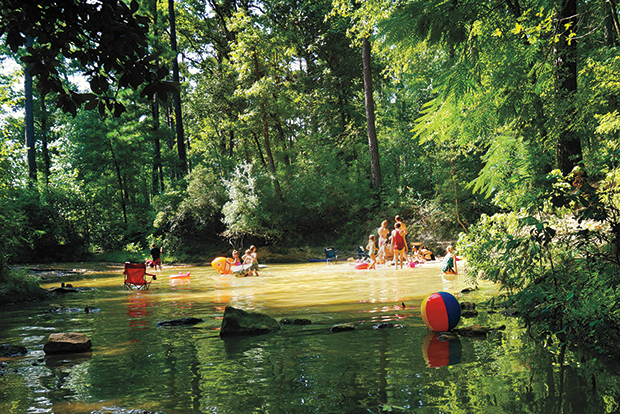
The 9-acre Boykin Springs Lake in Angelina National Forest offers swimming and non-motorized boating.
The Swimming Holes of Texas (UT Press) is in bookstores now. Signed copies are available at BookPeople in Austin.
Being on the road every weekend for four months straight compresses time. The whole summer sits in the front seat of my car, empty coffee cups at our feet, a cooler packed with hummus and tortillas in the back. One hundred and twenty days become one long river running north and south and east and west across Texas. We plan to explore the Piney Woods and desert; red rocks and rolling hills; Big Bend and the Buddy Holly Center; Lowbrows Beer and Wine Garden in Pilot Point and the Ol’ Watering Hole pub in Kerrville, where locals add dozens of spots to our list.
Mostly, researching The Swimming Holes of Texas looks like this: Saturday mornings, armed with iced coffee and breakfast tacos, we hit the road with our list. We are Thelma and Louise meets Lewis and Clark.
We visit Louise Hays Park in Kerr-ville, named for the wife of a man who decided to build an entire park in a single day. Three hundred miles later, we find Balmorhea, where desert rabbits at dusk watch me pitch a tent for the first time in my life, and San Solomon Springs is a sacred salve for our tired souls.
We find tiny parks on unnamed roads; patches of riverbank famous to locals and invisible to Google. These are the spots we are seeking in the vast Texas forever; the brilliant, unspoiled patches of quiet. Yes, we cover the big guns, too, the tubing spots in San Marcos and the Blue Holes in Georgetown and Wimberley; Barton Springs in Austin and Huntsville State Park near Houston. We thread our way through throngs of children and sunbathers and weekend swimmers and document it all, water temperature and river bottom and history and whether or not there is a snack bar. We revel in those places where life is slower and calmer.
We find Moffett Park in the tiny town of Medina, a crystal-clear spot off the beaten path that our GPS doesn’t pick up. We are in the middle of nowhere here, even though there are houses in view and a truck parked close to the banks. A rusted barbecue grill indicates the intent of this place, but otherwise the spot is undeveloped and unbothered. Carolyn ambles along the bank with her camera. I wade into the cold water with my notebook. We breathe in the blue sky, wish we could stay, and keep going.
Some of the spots we find don’t have names, so we make them up. On the steps of the Old Jail Museum in Gonzales, the town known as the famous site of the Come and Take It standoff, a tour guide named Leroy gives us a rundown of every restaurant and historic house within a mile. We ask him how to get to the part of the Guadalupe where we’d heard there was a rope swing and river access. He gives us the turn-offs, and we find the river just past the stone monuments that mark the spot in the field where those famous words were thrown down. We declare the spot the, “Come and Take It Historic Swimming Hole.” It is a name we make up for Leroy, more than anyone else.
By July we’re in the Texas Panhandle. The clock is ticking on our August deadline. We find Caprock Canyons State Park and Trailway, with its herd of bison and red rock opening up before us to prove that Texas is only getting bigger. The next weekend we head west to Del Rio, where children exult in the ice-cold spring water that runs through the center of the city on a 103-degree day. We find Amistad Reservoir stretching like an ocean to the shores of Mexico. The next day, fat flying black bugs chase us down the sun-bleached, mile-long desert path to Devils River.
In East Texas in early August we celebrate the shade of the Piney Woods and national forests. We pitch our tents along the Lake Bob Sandlin State Park waterfront, waking up to find the tub of vegan cream left on the picnic table licked clean by creatures in the middle of the night. In South Texas we stand in the burnt gold scrubland beneath the wide cumulus clouds of Choke Canyon State Park and heed warning signs about alligators we never see, though we wait and look.
By the end of the summer, I can pitch a tent in the dark. We have grown tired of all of our favorite CDs and scan the radio for classic country songs. We’ve counted dozens of East Texas donut shops. We have come home every time to our Austin skyline, our crystal clear Barton Springs and Deep Eddy pools. We have followed every river right back to where we’d begun, sun-kissed and tired, dropping a new set of pins and counting down until the next weekend, when we do it all again.








